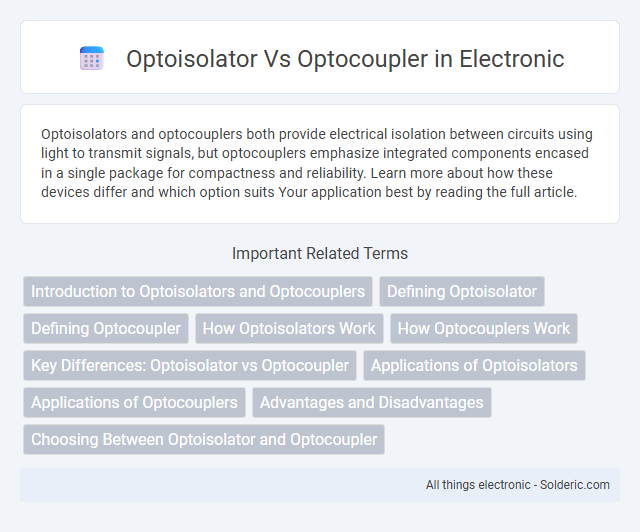Optoisolators and optocouplers both provide electrical isolation between circuits using light to transmit signals, but optocouplers emphasize integrated components encased in a single package for compactness and reliability. Learn more about how these devices differ and which option suits Your application best by reading the full article.
Comparison Table
| Feature | Optoisolator | Optocoupler |
|---|---|---|
| Definition | Device transferring electrical signals using light to provide electrical isolation. | Synonym of optoisolator; used interchangeably. |
| Function | Isolates input from output, protecting circuits from high voltages. | Same as optoisolator, couples input and output optically. |
| Components | LED (light source) + photodetector (phototransistor, photodiode). | LED + photodetector; similar internal structure. |
| Applications | Signal isolation in microcontrollers, industrial controls. | Used in same fields: communication, signal isolation. |
| Terminology | More formal term emphasizing isolation function. | Commonly used in commercial products; emphasizes coupling function. |
Introduction to Optoisolators and Optocouplers
Optoisolators, also known as optocouplers, are electronic components designed to transfer electrical signals between two isolated circuits using light. These devices typically consist of an LED and a photodetector, such as a phototransistor, photodiode, or photo-SCR, housed within a single package to ensure electrical isolation. Optoisolators are crucial in applications requiring noise reduction, signal isolation, and protection between high-voltage and low-voltage sections.
Defining Optoisolator
An optoisolator, also known as an optocoupler, is an electronic component that transfers electrical signals using light waves to isolate input and output circuits, preventing high voltages from affecting the system receiving the signal. It typically consists of an LED and a photodetector such as a photodiode, phototransistor, or photothyristor enclosed in a single package to ensure signal isolation. The primary function of an optoisolator is to provide electrical isolation while maintaining signal integrity across diverse electronic applications.
Defining Optocoupler
An optocoupler, also known as an optoisolator, is a semiconductor device designed to transfer electrical signals between two isolated circuits using light. It typically consists of an LED and a photodetector housed in a single package, ensuring signal transmission without direct electrical contact, which protects your equipment from voltage spikes and noise. This isolation is crucial in applications requiring electrical separation for safety and noise reduction.
How Optoisolators Work
Optoisolators work by using an internal LED to emit light that crosses an isolation barrier and activates a photodetector like a phototransistor or photodiode, ensuring electrical signals transfer without direct electrical connection. This design enables efficient noise reduction and protects sensitive components from voltage spikes and interference. Your circuits benefit from enhanced safety and signal integrity due to this optical isolation mechanism.
How Optocouplers Work
Optocouplers, also known as optoisolators, work by transmitting electrical signals through light to electrically isolate input and output circuits. Inside, an LED converts the electrical input into light, which is then detected by a photodetector like a phototransistor or photodiode, ensuring signal transfer without direct electrical connection. This isolation protects your devices from high voltages and reduces noise, improving overall circuit safety and performance.
Key Differences: Optoisolator vs Optocoupler
Optoisolators and optocouplers are essentially the same components, designed to transfer electrical signals using light to provide electrical isolation, with the terms often used interchangeably. Key differences arise mainly from regional terminology and specific applications, where "optocoupler" emphasizes coupling functionality in signal transfer, while "optoisolator" highlights isolation capability. Both devices typically consist of an LED and a photodetector, ensuring signal integrity and preventing high voltages from affecting sensitive electronics.
Applications of Optoisolators
Optoisolators are widely used in industrial automation to safely transmit signals between high-voltage systems and sensitive electronics, preventing electrical noise and voltage spikes. They are essential in medical equipment for isolating patient-connected devices from power circuits, ensuring patient safety. Optoisolators also play a critical role in communication systems for isolating data signals, improving signal integrity and protecting components from electrical interference.
Applications of Optocouplers
Optocouplers are widely used in isolating high-voltage circuits from low-voltage control systems, ensuring safety and signal integrity in industrial automation and power supply units. They provide effective noise reduction and prevent ground loops in communication interfaces like UART, SPI, and I2C used in embedded systems. Additionally, optocouplers enable reliable switching of AC or DC loads in motor drives, lighting controls, and audio equipment, enhancing system robustness and performance.
Advantages and Disadvantages
Optoisolators and optocouplers both provide electrical isolation using light transmission, but optoisolators typically integrate simpler components for faster response times and lower cost, while optocouplers offer enhanced functionality with built-in amplifiers or sensors. The main advantage of optoisolators is their ability to protect circuits from high voltages and noise, though they may suffer from limited bandwidth and signal distortion. Your choice should balance isolation requirements and signal fidelity, as optocouplers can handle more complex signal conditioning but may increase size and complexity.
Choosing Between Optoisolator and Optocoupler
Choosing between an optoisolator and an optocoupler depends on the specific application requirements for electrical isolation and signal transmission. Optoisolators provide high-voltage isolation and noise immunity by using light to transfer signals across an isolation barrier, making them ideal for protecting sensitive components in industrial and medical equipment. Optocouplers, often used interchangeably with optoisolators, may include integrated components such as phototransistors or photodiodes, offering a variety of output types and response speeds, which should be matched to the circuit design and performance criteria.
optoisolator vs optocoupler Infographic

 solderic.com
solderic.com